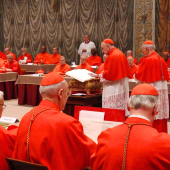Holy Father says first nativity scene teaches simplicity and joy

Pope Francis talked about the teachings on simplicity and joy in his reflection on the first Nativity scene during his final General Audience before Christmas, according to Vatican News.
Inaugurated 800 years ago by St. Francis of Assisi in the small Italian Umbrian town of Greccio, the Holy Father said the saint’s intention in organizing a living Nativity wasn’t “to create a beautiful work of art but to provoke amazement at the extreme humility of the Lord, at the hardships He suffered, for love of us, in the poor grotto of Bethlehem.”
In the face of the mystery of the incarnation of the Word, of the birth of Jesus, we need this religious attitude of amazement, said Pope Francis. He characterized the Nativity scene with soberness and joy.
It was created “to bring us back to what truly matters: to God Who comes to dwell among us,” said Pope Francis of soberness, which contrasts with the hustle and bustle of the holiday season and the consumerism that too often marks Christmas.
“The joy that overflows from the heart that has tangibly experienced “the closeness of Jesus, the tenderness of God, who does not leave us alone but stands with those who are alone,” is how Pope Francis described the joy of Christmas that does not come from sumptuous presents or lavish celebrations.
He compared the Nativity scene to a well from which people can draw the nearness of God, “the source of hope and joy.”
“The Nativity scene is like a living Gospel, a domestic Gospel. And like the well in the Bible, it is a place of encounter where we bring to Jesus the expectations and worries of life, just as the shepherds of Bethlehem and the people of Greccio did," said Pope Francis.
He encouraged everyone to look upon the scene in the manger and to allow themselves to feel something within: “Let us go before the Nativity scene.” (MTV)
Radio Veritas Asia (RVA), a media platform of the Catholic Church, aims to share Christ. RVA started in 1969 as a continental Catholic radio station to serve Asian countries in their respective local language, thus earning the tag “the Voice of Asian Christianity.” Responding to the emerging context, RVA embraced media platforms to connect with the global Asian audience via its 21 language websites and various social media platforms.














